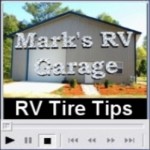 It seems as though I talk about tire safety all of the time. The reason I do is because tires are an important safety topic concerning RVers that are often times overlooked. Just recently I read a newspaper article that summed up just how overlooked tires, in general, are. The article stated, “The Rubber Manufacturers Association found that 29 million drivers believe that tires require no regular maintenance.” This number might be considered small when compared to our current deficit, but it is quite large when you consider 29 million people are driving around the country on tires they don’t know the condition of.
It seems as though I talk about tire safety all of the time. The reason I do is because tires are an important safety topic concerning RVers that are often times overlooked. Just recently I read a newspaper article that summed up just how overlooked tires, in general, are. The article stated, “The Rubber Manufacturers Association found that 29 million drivers believe that tires require no regular maintenance.” This number might be considered small when compared to our current deficit, but it is quite large when you consider 29 million people are driving around the country on tires they don’t know the condition of.
With peak travel season quickly approaching I thought it would be a good time to offer some tire tips for safer trips. These tire tips apply to your automobile as well.
Watch the RV Tire Tips Video
Two of the biggest problems with RVs today are overloading the RV and under inflated tires. With multiple slide-out rooms, large holding tank capacities and the ample amount of storage space available on today’s RVs it’s easy to see why so many are overloaded. We have a natural tendency to fill every nook and cranny of available storage space on our RVs.
Another problem is out of balance loads. You can be within an axle or tire’s load capacity on one end of an axle, and be over capacity on the other axle end. This is a common problem with RVs and many times the cause is poor weight distribution and/or improper loading of the RV. When this happens the tire or tires on the end of the axle that is overloaded are subject to tire failure. The bottom line is overloaded RVs and under inflated tires can be extremely dangerous. The only way to make sure that your RV is not overloaded is to have it weighed.
Weight ratings for RV’s are established by the manufacturer and are based on the weakest link in the chain. When you exceed a weight rating you are overloading one or more components on the RV and risk wearing the component out prematurely or complete failure of the component. In many cases the tires on your RV are the weakest link. Just like the axles on your RV, your tires have load ratings too. The maximum ratings are molded into the side of the tires. Keep in mind these are maximum ratings. The sidewall of the tire shows the maximum load and the inflation pressure for that load. Never set the inflation pressures below the recommendations you find on the vehicle manufacturers placard and do not exceed the maximum inflation pressure ratings found on the tires sidewall.
The tires on your RV are the most vulnerable component affected by overloading the RV. There are numerous reasons for this. First and foremost is when the tires are not inflated properly for the load. Failure to maintain correct tire pressure can result in fast tread wear, uneven wear, poor handling, and excessive heat buildup, which can lead to tire failure.
The only way to correctly measure the inflation pressure in your tires is with a quality inflation pressure gauge. Using your boot, a billie club or a hammer is not accurate, and never depend on your eyes to check tire inflation. There can be as much as 20 PSI difference between tires that look the same to your eye. You need to invest in an accurate inflation pressure gauge. You should get one with a double, angled foot. This makes it much easier to check the outer tire of a dual set. Read my Tire Pressure Gauge article
Check all of your tires on a regular basis and adjust the pressure according to the manufacturer’s recommendation. Never check inflation pressure when the tires are hot. You’ll get a higher-pressure reading and if you let some air out they will be under inflated when they are cold. If you have dual wheels you’ll want to add extension hoses to the valve stems to make the job of checking tire inflation easier. It can be nearly impossible to check the inner dual without extension hoses. The best extension hoses will have stainless steel reinforcement and external braiding for long trouble-free life.
Ozone in the air and UV rays from the sun shorten the life of your tires. It’s not uncommon to see RV tires with low mileage and plenty of tread that are ruined by the damaging effects of ozone and UV rays. Ozone in the air causes tires to dry rot and deteriorate. UV rays from the sun make it happen quicker. This is especially true of the tires sidewall. Inspect your tires for checking or cracks in the sidewalls. If you notice any damage to the tires have them inspected by a professional.
Keep the tires covered with covers that will block out the sunlight when you’re not using your RV. You should also place something like a piece of wood between the ground and the tires. Be sure that whatever you use is larger than the footprint of the tire. No portion of the tire should hang over the edge of the tire block. This can cause internal damage to the tire.
Occasionally washing your tires with soap and water is OK, but anything beyond that can actually shorten the life of your tires. Sidewall rubber contains antioxidants and anti-ozones that are designed to work their way to the surface of the rubber to protect it. Washing tires excessively removes these protective compounds and can age tires prematurely. The same is true of most tire dressing designed to make your tires shine.
Tire failure can be extremely dangerous and can cause extensive damage to your RV. There are no guarantees, but by practicing good tire maintenance you can feel much safer and secure that the weakest link on your RV will do its job while you’re out exploring this wonderful country we live in.
If you would like to learn more about maitaining your RV check out our RV Care & Maintenance DVD
Happy Camping,
Mark Polk
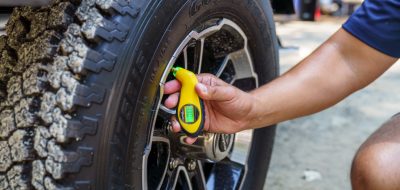
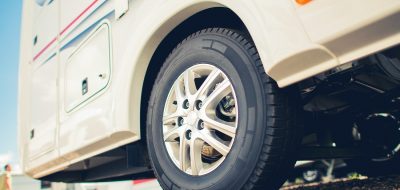

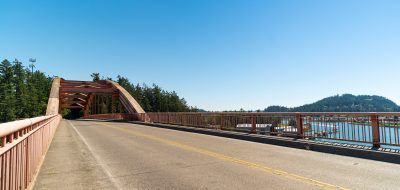

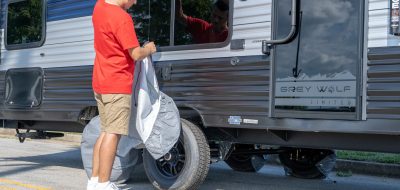
Pingback: my url
Henry Williams
Hi Just wanted to know about replacing my fifth wheel tires. The size on it now are Lt235/85R/16 E Load. Is this a light truck tire? They were on it when I bought the fifth wheel new. They are 7 years old, and I know it is time to replace them. The Montana wights 12,000 lbs loaded. My question is it ok to replace with the same size tires. And if so what is a good brand to replace with? Thanks Mr. Williams
nick
Hello, I am probably doing this wrong but I am a very new rv’r and I have about zero knowledge when it comes to vehicle maintenance and things of that nature. I recently purchased a 1999 Winnebago Minnie 31C and I have been having lots of problems with the tires. I am currently on a cross country expedition with the family and I have had one major blowout and 2 tires just go flat for no good reason. One of my flats occured after I had 4 brand new tires installed on the back of the rig. I have a automatic Hydrolic leveling jacks and I am currently parked in my sister in Laws driveway. I am a little off being level in the back but not by much. While I was parked the inner right tire on my dual tire totally deflated and looks like it had something indent it. Right now I am at a loss to my tire troubles. I guess a couple of questions I have are is it absolutely necessary to have blocks underneath the jacks to get it perfectly even? Should a little of the RV’s weight resting on the tire make it go flat? I would appreciate any advice or help that anyone can give. Thank you
Bill Conte
I had an inner right tire blow after driving from Hilton Head to Roanoke in March. The Service man that changed the tire said to take the extenders off the inner rims…..he said even though they were stainless steel etc…..they will eventually slowly leak..the tire that blew was a classic “zipper blow out” from too low pressure”. I had checked all 6 when we left Hilton Head and all were exactly 90PSI…the intn was not havily loaded.
I do not have a tire pressure monitoring system…I will have one very soon…….. When the second tire service man came to mount the new tire and put the spare back after I arrived home…he said the same…and put an extra long brass valve stem and bent it slightly so it was easily reachable when fully mounted.
I guess the best policy is to spend the 400.00 for a tire pressure monitoring system….before a blow out tears the fender off the unit or the steel belt rips through the floor of the unit………as they both had seen over the years.
Any comments on the continued use of extenders??????
charles cox
Having just had a blow out on one of my rear tires- I sure do recommend replacing “old” tires even if they look ok.
I weighed the front and rear separately – with the tow car attached and checked the tire pressure for that total weight divided by 4 rear tires to get the estimated weight for each tire. and divided by 2 to get a weight for the front tire. (I don’t know if this is a correct way to do it)
I couldn’t figure out how to weigh each tire on my local feed store scale .
Now that I’m getting 4 new tires on the rear- is there any way I can weigh the tires separately to get the correct pressure (as seen in Goodyear RV load chart)? thanks
Mark Polk
Earl,
In a Firestone tire brochure for RV’s they put it like this:
“Cold” means when they are at the same temperature as the outdoor air. It goes on to say, The way to make sure your tires are cold is to either park the vehicle and wait at least 3 hours before checking pressures, or to let the parked vehicle sit overnight and check the pressures before you’ve driven it a mile.
It makes no mention of the actual temperature.
Earl McLaughlin
What is the temp of a “COLD TIRE”?
Mark Polk
Rick,
The only way to know the proper tire inflation for sure is to have the unit weighed, which you did. Based on the actual weight they used the tire load inflation chart and recommended 85 PSI cold. This is the proper inflation pressure for your tires at the time it was weighed.
The 90 PSI you referred too is the manufacturer recommendation found on the safety certification label. Basically they are saying that based on your coach, (without weighing it when fully loaded) they recommend 90 PSI. So if a person didn’t have their unit weighed this is the inflation pressure I would go with.
The 110 PSI on the tire sidewall is the maximum pressure you can inflate the tires too, and would only be used if the maximum amount of weight the tires can support was actually placed on the tires.
You did the right thing by weighing the unit and getting the inflation pressure directly from the load inflation charts. Just keep in mind that weighing the unit is like a snapshot in time. When you add more weight or redistribute weight the actual weight on the tires can and will change. But you are much further ahead of many other people when it comes to good tire maintenance and safety.
Mark Polk
Drew,
On a trailer my recommendation is to always use Special Trailer (ST) tires. They are built with stiffer sidewall than Light Truck (LT) tires. These stiffer sidewalls can handle the pressure excerted on the tires when turning, and in general provide safer towing. More flexible sidewalls, like used on LT tires, don’t perform nearly as well on trailer applications.
Rick
Thanks Roger,
I believe my problem was the change in temperature as I put my RV in cold storage in the winter. It gets pretty cold in KS in the winter. Also I have had the RV going on three years and have never had the tire pressure checked. I bet I check the pressure every year. I hope I have no leaks if I did I believe the tires would have gone flat before now.
Thanks again
Phil Schoner
Cold pressure means before driving on them. However, no one seems to know or specify ambient temperature at time of testing. I find that the pressure increases as much as 15 psi between 40 and 80 degrees F., both of which are common ambient temps.
Also, don’t test one tire that has been exposed to the sun and compare it to the tire on the other side of the RV that has been in the shade. If you then equalize the 2 pressures you get, you will be low on the sunny side tire.
Phil
Rick
Hi Mark, Question, Your article stated to fill tires to manufacturers recommendation. Would that be the tire manufacturer or the coach manufacturer? Tires say 110 psi cold, coach says 90 psi cold. Had coach weighed at 3T’s in Havasu City and they provided me a chart that says based on my coach weight at each tire location to use 85 psi cold. What is your take?
Thanks, Rick
Roger
Just to let people that are going to either FMCA GLASS rally in Mich in a couple of weeks or to the FMCA Int’l in Bowling Green in July, I am giving a talk on Tire Basics for the RV owner.
I am also offering a service to allow attendees to compare their gage against my calibrated tire gauge.
Rick it is a good rule of thumb that tires change 1 psi for each change in 10 ure.degrees change in temperature. Also tires loose about 2% per month. This assumes no leaks in the tire, wheel or valve.
Drew
Hello Mark,
On 5th wheels and other trailers do you recommend using “ST” tires or something rated for general truck use?
Rick
Hey Mark,
You are correct on the tire pressure. I had my RV serviced this pass weekend and I had them check the tire pressure. I was low about 10 to 15 pounds a tire. I sure could tell a big change when I drove my RV back home. I believe the cold and hot weather has something to do with it. You are right you can not tell if the tires are low just buy looking at them.
Thanks for the information, I believe you have saved me some gas money on my next trip.
Thanks again